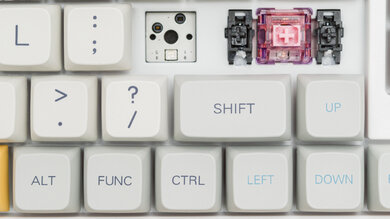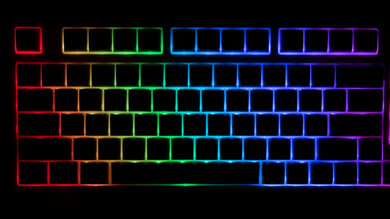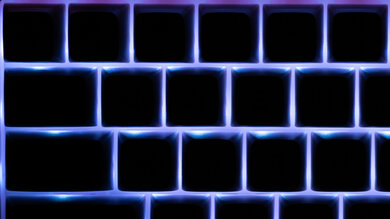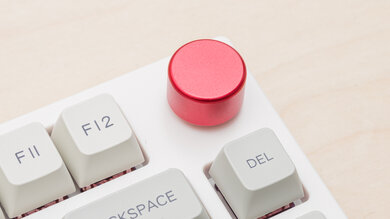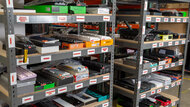The Epomaker TH80 Pro is a wireless mechanical keyboard in Epomaker's TH lineup of keyboards. It features MDA profile keycaps made of PBT plastic with dye-sublimated legends. You can purchase these keyboards in one of two keycap themes and with various Epomaker and Gateron Pro switches. It also has a hot-swappable PCB, so you can easily change the stock switches for those of your choosing.
Our Verdict
The latency of the Epomaker TH80 Pro is too high for competitive gaming, but it's excellent for more casual gaming in any genre. It has great build quality and is available in a range of stock Epomaker or Gateron Pro switches. We tested this keyboard with Epomaker Flamingo switches which are very lightweight and have very short pre-travel providing an extremely sensitive and responsive-feeling gaming experience.
-
Impressive build quality.
-
Good latency for casual gaming.
-
Companion software compatible with Windows and macOS.
-
Latency is too high for competitive gaming.
-
Can't see key legends in darkened rooms.
The Epomaker TH80 Pro is good for office use. It feels well-built and delivers impressive typing quality. It connects wirelessly with its USB receiver or with up to three devices simultaneously via Bluetooth. We tested this keyboard with Epomaker Flamingo switches which are very sensitive linear switches with short pre-travel; it's also available in a range of other Epomaker and Gateron Pro switches. Note that this keyboard has a high profile; use it with a wrist rest for the most comfortable experience, but it doesn't come with one in the box.
-
Impressive build quality.
-
Great typing quality.
-
Companion software compatible with Windows and macOS.
-
Linear switches are reasonably quiet but may bother those around you if they're particularly noise-sensitive.
The Epomaker TH80 Pro is satisfactory for use with mobile and tablet devices. It has impressive build quality, and you can pair it wirelessly with up to three devices simultaneously. However, its tall profile makes it fairly bulky despite its compact form. It's also quite heavy.
-
Impressive build quality.
-
Supports multi-device pairing with up to three devices via Bluetooth.
-
Has a bulkier, high profile design and is heavy for its size.
The Epomaker TH80 Pro is great for programming. It's well-built and offers impressive typing quality. We tested this keyboard with Epomaker Flamingo switches which are very sensitive switches with short-pre travel, but it's also available in various other stock Epomaker and Gateron Pro switches. Note that this keyboard has a high profile; use it with a wrist rest for the most comfortable experience, but it doesn't come with one in the box.
-
Impressive build quality.
-
Great typing quality.
-
Companion software compatible with Windows and macOS.
-
Can't see key legends in darkened rooms.
-
No dedicated macro keys.
-
Linear switches are reasonably quiet but may bother those around you if they're particularly noise-sensitive.
The Epomaker TH80 Pro is adequate for entertainment or home theater setups. It connects wirelessly via a USB receiver or Bluetooth and has full RGB backlighting. However, you can't see the legends of the keys in a darkened room. It also lacks dedicated media keys and is fairly heavy and bulky.
-
Impressive build quality.
-
Can't see key legends in darkened rooms.
-
Has a bulkier, high profile design and is heavy for its size.
-
No dedicated media keys.
-
Impressive build quality.
- 7.7 Gaming
- 7.7 Office
- 7.1 Mobile/Tablet
- 7.7 Programming
- 6.0 Entertainment / HTPC
- 7.5 Raw Performance
Changelog
- Updated Oct 16, 2024: We've added a link to the newly-reviewed AULA F99/F75 to the Typing Quality section.
- Updated Dec 05, 2023: We've added a link to the newly-reviewed Keychron Lemokey L3 in the Hardware Customizability section of this review.
- Updated Nov 29, 2023: We've converted this review to Test Bench 1.3.1, which adds a new estimated PCB latency test to the Single-Key Latency section and a new Analog test to the Switches section of this review. You can see the full changelog here.
- Updated Oct 16, 2023: We've converted this review to Test Bench 1.3, which overhauls how key input is evaluated. We've added new tests for Single Key Latency, Multi Key Latency, Data Transmission, and Chord Split. We've also introduced a new Raw Performance usage and adjusted how the Gaming and Office usage scores are calculated. You can see the full changelog here.
- Updated Sep 06, 2023: We've added a link to the newly-reviewed NuPhy Field75 to the Latency section of this review.
Check Price
Differences Between Sizes And Variants
We bought and tested the Epomaker TH80 Pro with the Theory MDA keycap theme and Epomaker Flamingo switches. You can see the label of the unit we bought and tested here.
We expect our review results to apply to the Epomaker TH Pro series keyboards listed below. Epomaker produces a range of TH Series keyboards in different sizes and configurations. You can check out their website if you're interested in the entire Epomaker TH Series lineup.
| Name | Size | Connectivity | Battery Size | Theory MDA theme keycap switch options | Monet MDA V2 theme Switch Options | Barebones Kit Available |
| Epomaker TH80 Pro | Compact (75%) | 2.4Ghz/Bluetooth/Wired | 4000 mAh |
Epomaker Flamingo, Epomaker Budgerigar, Gateron Pro Black, Gateron Pro Blue, Gateron Pro Brown, Gateron Pro Red |
Epomaker Flamingo, Epomaker Budgerigar, Gateron Pro Yellow | Yes |
| Epomaker TH66 Pro ** | Compact (65%) | 2.4Ghz/Bluetooth/Wired | 2200 mAh | Epomaker Flamingo, Epomaker Budgerigar, Gateron Pro Black, Gateron Pro Blue, Gateron Pro Brown, Gateron Pro Red | Epomaker Flamingo, Epomaker Budgerigar | Yes |
** The F-row keys for the Epomaker TH66 Pro have north-facing LEDs. All other keys have south-facing LEDs. Epomaker recommends only using Gateron SMD switches for the TH66.
Compared To Other Keyboards
The Epomaker TH80 Pro is a wireless mechanical keyboard in Epomaker's TH series. This keyboard offers a package with more premium-feeling construction and typing experience similar to keyboards from Ducky or GLORIOUS but at a lower mid-range price point. This keyboard also adopts aesthetic qualities generally found on more expensive custom or group-buy keyboards. That said, its latency is too high for competitive gaming, but it's a great choice for casual gaming or light workloads and everyday browsing.
For more recommendations, see our picks for the best wireless keyboards, the best mechanical keyboards, or the best keyboards for typing.
The Epomaker TH80 Pro and the Keychron V1, from the Keychron V Series, are mechanical keyboards with a compact (75%) form factor. Both keyboards have an all-plastic construction. The V1 is a wired-only option that feels a bit sturdier overall and quieter thanks to several layers of sound-dampening foam inside the case. On the other hand, the Epomaker is a wireless model that has somewhat lower latency.
The Epomaker TH80 Pro and the AULA F75 are wireless, entry-level mechanical keyboards. The Epomaker has better overall build quality with a sturdier chassis made of higher-quality plastic. On the other hand, the AULA has slightly better typing quality with a significantly springier-feeling gasket mount design. It also has better overall gaming performance. Unfortunately, its buying experience is more confusing as the online retail documentation is very poor, and there's some uncertainty about exactly what components you'll receive in your board when you buy it.
The Epomaker TH80 Pro and the Keychron Q1 Pro are wireless mechanical keyboards with compact (75%) form factors. The Epomaker has multiple incline options and an all-plastic construction. On the other hand, the Keychron has a more premium-feeling build quality with an aluminum case. It also has a gasket-mounted design that provides a softer, more cushioned typing experience.
The NuPhy Kick75 and the Epomaker TH80 Pro are wireless mechanical keyboards with compact 75% layouts. The NuPhy is available in either a standard or low-profile version, and NuPhy offers conversion kits for separate purchase that let you switch between the two. It also offers noticeably better typing quality out of the box and has better raw gaming performance. On the other hand, the Epomaker has slightly better build quality.
The Epomaker TH80 Pro and the GLORIOUS GMMK PRO are mechanical keyboards with a compact (75%) form factor. The Epomaker is a wireless model with an all-plastic construction and is available in two different keycap themes and several switch options. On the other hand, the GLORIOUS is a wired-only model with a more premium-feeling aluminum case construction and is available with a broader range of stock keycaps and switch types.
The NuPhy Halo75 and the Epomaker TH80 Pro are wireless mechanical keyboards with a compact (75%) form factor. The NuPhy is quieter thanks to several layers of silicone-dampening material inside the case. On the other hand, the Epomaker is available for purchase in two keycap themes and has a control knob, which the Nuphy lacks.
The NuPhy Field75 and the Epomaker TH80 Pro are wireless mechanical keyboards. The NuPhy is more gaming-focused, with significantly better latency performance. The NuPhy also has layers of internal sound-dampening material, dedicated macro keys, and additional control knobs which the Epomaker lacks. On the other hand, the Epomaker configuration software is available for Windows and macOS, while the NuPhy only has software available for Windows.
The Epomaker TH80 Pro and the Keychron Lemokey L3 are wireless keyboards with TenKeyLess (80%) layouts. The Epomaker is designed more with productivity and everyday browsing in mind, while the Keychron is designed primarily for gaming and has better latency performance. The Keychron also feels better built overall, and its double-gasket mounted design and layers of internal case foam provide a somewhat more premium-feeling typing experience.
Test Results
This keyboard has a compact (75%) form factor and a slightly unusual layout with several fewer navigation keys than most 75% keyboards. It has a set of arrow keys but lacks a numpad and most keys from the navigation cluster.
This keyboard has impressive build quality. It's made entirely of plastic but doesn't flex and has a premium feel. The keycaps are made of high-quality PBT and exhibit very minimal wobbling, and four rubber strips on the bottom of the keyboard keep it stable and firmly in place while you're typing.
Two plastic feet flip out to provide two additional incline settings to suit your preferences, but the keyboard has a fairly high profile, and you need to angle your wrists to reach all the keys. It doesn't come with a wrist rest, but using one provides the most comfortable experience. Epomaker does sell wrist rests separately on their website.
These keyboards offer outstanding hardware customizability. Just note that the modifier keys on the right side of the keyboard are 1u rather than the more common 1.25u.
If you're interested in a similar wireless keyboard that provides slightly better hardware customizability with screw-in stabilizers and standard 1.25u-sized right-side modifier keys, check out the Keychron Lemokey L3.
Unfortunately, the color mixing is poor and has a noticeable blueish-purple hue. The stock keycaps don't have shine-through legends, and you can't read them in the dark. Furthermore, this keyboard has south-facing LEDs, so if you're considering changing the stock switches with shine-through keycaps, note that they will only have minimal visibility.
For reference, we've taken a photo of this keyboard with the W, A, S, and D keys replaced with shine-through keycaps that you can see here.
This keyboard comes with a detachable charging cable. It's braided and retains some kinks from the packaging.
This keyboard has a 4000mAh battery. Epomaker doesn't list any battery life expectancy on the product page; other sources online estimate approximately seven days of battery life while connected via Bluetooth and up to five days connected with its USB receiver.
If you have this keyboard and would like to let us know about the battery life from your experience, let us know in the forums.
This keyboard lacks dedicated macro keys, but all keys are macro-programmable using the customization software.
An unlabeled switch on the bottom of the keyboard toggles left for wired mode and right for wireless mode. There's a list of hotkey combinations in the user documentation included in the box, or you can also download this documentation on Epomaker's website.
This keyboard offers impressive typing quality overall. The keys are quite stable and well-spaced, especially given the compact form factor. However, there's some minor wobble on the larger keys while typing. The spacebar also feels a bit mushier than other large keys with stabilizers like the Enter and Shift keys.
The keycaps feel great to type on and are made of PBT plastic with dye-sublimated legends. They have a drier-feeling texture and are typically more resistant to developing a shiny appearance from fingerprint oils compared to some ABS plastic keycaps. These keycaps also have an MDA profile, which is slightly taller and more sculpted than OEM profile keycaps.
If you're interested in a keyboard that offers a slightly better typing experience with a very soft and springy gasket mounting system, see our review for the AULA F75.
We tested this keyboard with linear Epomaker Flamingo switches, which are reasonably quiet but may bother those around you if they're particularly noise-sensitive. This keyboard is also available with other stock switch types. We expect other linear options to be a similar volume while typing, but stock tactile and clicky switches will be louder.
We tested this keyboard with EPOMAKER linear Flamingo switches, which are very lightweight and have very short pre-travel providing extremely sensitive and responsive feeling keystrokes.
Depending on the keycap theme you choose to buy, this keyboard is also available with various Gateron Pro switches or with tactile EPOMAKER Budgerigar switches, which are only marginally heavier than the Flamingo switches but have a tactile bump.
This keyboard has good latency overall and is well-suited for casual gaming in all genres. However, it's higher than the latency of most dedicated gaming keyboards, and we recommend a model with under 4ms latency if you're interested in playing reaction-based or competitive gaming.
For a similar keyboard with lower latency that's better suited for fast-paced, competitive games, check out the NuPhy Field75.
This keyboard uses EPOMAKER Driver companion software. The software allows you to adjust backlighting, record macros, and remap keys. You can also save settings to the onboard memory and use them on other computers without the software installed. Altogether, the software is well laid out and simple to use, but it's slow, and changing settings results in a momentary loading screen.
This keyboard is fully compatible with Windows, macOS, and Linux. It also automatically detects the operating system when connected to a Mac or Windows computer and switches modes accordingly. On macOS, all keys work as intended, but if you're not using an Apple screen, the F1 and F2 keys, which typically control brightness, don't work. On Linux, the F3 and F4 keys do nothing.
These keyboards are fully compatible with Android, iOS, and iPadOS. However, there's no customization software available, and the F11 key does nothing.
Comments
Epomaker TH80 Pro: Main Discussion
Let us know why you want us to review the product here, or encourage others to vote for this product.
- 21010
The build quality is impressive, the keycaps are top-notch, and the switches are high-quality. The only notable drawback I encountered was a slight delay when connecting via 2.4 GHz mode. Aside from that, it’s an outstanding keyboard that I wholeheartedly recommend.
Update: We’ve added a link to the newly-reviewed AULA F99/F75 to the Typing Quality section.
- 32120
I usually use my keyboards wired anyways. Unlike my mouse, I’m not constantly moving it all over the place so the freedom of wireless here makes less of a positive difference here.





